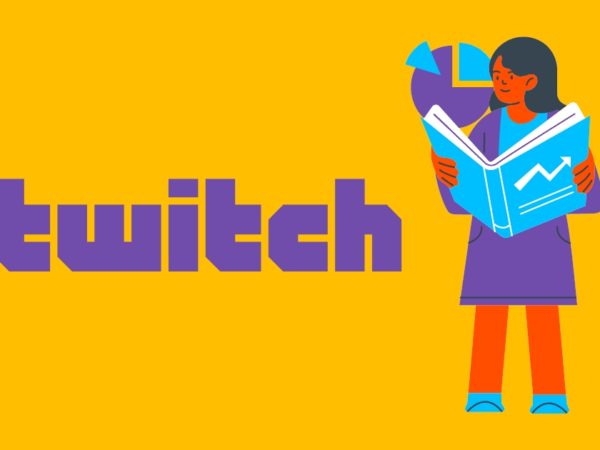Google Web Stories help your audience digest your content effortlessly and as quickly as possible and create a long-lasting impression on the consumer.
Snapchat took the social media engagement by storm by releasing the Snapchat Story content type. Later, Facebook and Instagram followed the same idea and created their versions of social media stories.
Seeing the tremendous success of social media stories through millions of likes, views, and click-throughs, Google has also launched similar content for its mobile platforms. Branded as Google Web Stories, it offers website owners multiple marketing and engagement opportunities.
Read on to learn Web Stories from Google inside out and jump-start creating highly performing short-form content for mobile platforms.
What Are Google Web Stories?
<img alt="YouTube video" data-pin-nopin="true" data-src="https://kirelos.com/wp-content/uploads/2022/08/echo/hqdefault.jpg630e07cf801f3.jpg" height="360" src="data:image/svg xml,” width=”480″>
Web Stories are short-spanned video-like content that pops up on Google Discover, Google Search, and Google Image Search on mobile devices. Mostly, marketers host such stories on their websites. Some, however, use the hosting services provided by Web Story production tools like Newsroom.AI or MakeStories.
Formerly knowns as AMP Stories, Web Stories now consist of videos, images, texts, graphics, AR assets, etc. A Web Story can contain up to 30 slides or pages, but 15 to 20 slide-long content offers the best click-through rates and views.
Content creators can use such stories to share information in bite-sized content. On the other hand, marketers can use Web Stories to promote products/services and also take customers directly to shopping carts since Web Stories are tappable.
Features of Google Web Stories
<img alt="YouTube video" data-pin-nopin="true" data-src="https://kirelos.com/wp-content/uploads/2022/08/echo/hqdefault.jpg630e07cf86ed6.jpg" height="360" src="data:image/svg xml,” width=”480″>
Web Stories are viral due to their defined features. It helps creators to design and produce stories according to Google’s guidelines. Some of the notable features are:
- Web stories let you use multiple creative contents in one asset. For instance, you can include a few texts, illustrations, stock images, real images, videos, vectors, shapes, etc.
- Web Stories use AMP technology and cover the entire mobile or tablet screen for an immersive experience.
- Such story contents also allow advanced creators to inject 3-D augmented reality (AR) assets that can be visualized on virtual reality (VR) goggles.
- Web Stories are compatible with hyperlinks, shopping cart links, landing page links, and backlinking of own website content.
- Web Stories also come with a defined metadata policy for SEO assistance. The minimal metadata fields are publisher-logo-src, title, publisher, and poster-portrait-src.
What Do Google Web Stories Do?
Web Stories are primarily mobile-focused short visual content to support the creator economy. Such stories are mostly video oriented and come with tappable links. Using such links, readers can reach your website or blog and subscribe to newsletters.
Essentially, this increases the monetizability of your website. Some content creators also monetize Web Stories using third-party add tools or Google Ads.
Sales and marketing agencies and businesses can use Web Stories to promote their services, merchandise, and product. Furthermore, Web Stories help marketers to increase their conversion rate by directly taking the consumers to shopping carts.
The ultimate goal of Web Stories is to offer quality content and information to Google users through an immersive experience that is mobile-friendly and loads fast.
Google Web Stories Are Beneficial and Trending
Web Stories are becoming viral among content creators and marketers faster because of their endless possibilities and benefits. Hence, it has become trending content in the present day. Find below some benefits of Web Stories:
- Google Web Stories increases your brand’s or website’s visibility on the internet.
- Web Stories never expire and are hosted directly on your domain. Hence, you and your audience can always access your stories.
- Anyone with a mobile phone and basic internet can access your Web Stories.
- There are many free and paid Web Story creation tools that you can use to produce stories faster than other content.
- Viewers and readers feel more urge to view Web Stories rather than going through long articles or videos.
- Web Stories are the most inexpensive way of creating backlinks for your website and blog site.
- There are monetization opportunities for high-quality Google Web Stories.
<img alt="YouTube video" data-pin-nopin="true" data-src="https://kirelos.com/wp-content/uploads/2022/08/echo/hqdefault.jpg630e07cfcb479.jpg" height="360" src="data:image/svg xml,” width=”480″>
Types of Web Stories to Create for Google
The types of Web Stories for Google Search, Discover, or Image Search depend entirely on your editorial pattern. However, Google has seen potential success in the following types:
- 3rd-person narrative stories
- 1st-person narrative stories
- Live Web Stories
- Updating stories
- Evergreen stories
- Educational stories or how-tos
- Stories that tell about an experience
- Listicles of great products or services
- Polls and Quizzes
Whichever type you choose, ensure that you follow a standard Google-suggested pattern, which is the story’s opening, narration, and ending. Since you are in full control, you can also experiment with your Web Story type.
Though the idea of a Web Story is similar to that of social media stories you consume on Instagram, Facebook, or Snapchat, there are some fundamental differences. These are:
- You host the Web Stories on your domain.
- You can monetize Web Stories using Google Ads or other tools.
- You control your Web Story from a creative angle. The stories could mix texts, vectors, graphics, videos, images, and links.
- You can redirect users to your websites, landing pages, or shopping carts using hyperlinks.
Not to mention, Web Stories appear on various platforms like your website, Google Search engine, Google Discover, and Google Image Search pages.
How to Create Google Web Stories
<img alt="YouTube video" data-pin-nopin="true" data-src="https://kirelos.com/wp-content/uploads/2022/08/echo/hqdefault.jpg630e07cfd2dd8.jpg" height="360" src="data:image/svg xml,” width=”480″>
Draft an Outline or Storyboard
For any video-based content, you need a storyboard. You can also plan the content of each Web Story page using an outline.
Select A Visual Editor
Choose any Web Story creation tools that are available online. If you have hosted your website on WordPress, there is a dedicated WP plugin. Find more about it in the tools section below.
Source Images, Videos, and More
Procure copyright-free images, videos, GIFs, and animations that are not pixelated or stretched. You get the best result when you create such assets on your own. Also, do not forget to include vector illustrations, shapes, graphics, a few text, and tappable buttons.
Create the Web Story
Now, follow the storyboard and content outline to build the final content. Place the assets aesthetically, keep on checking content preview, and improvise.
Publish the Content
Most visual editors have a Publish button. Just click on that, and your content will be online.
Best Practices for Creating Google Web Stories
Engaging Elements
User interaction is a major objective behind Web Stories. Hence, use many interactive elements like call-to-action buttons, hyperlinks, tappable graphics, polls, quizzes, etc. Also, deliver the content in multiple slides instead of one cluttered slide.
Video-First Storytelling
Your Web Story should be video-centric. Use real or self-created videos as much as possible. You can also use animations, a few texts, images, and audio to set the narrative of the content.
Brand Identity
Use brand logos, color palettes, and photos to boost your brand’s visibility.
Web Story Accessibility
<img alt="YouTube video" data-pin-nopin="true" data-src="https://kirelos.com/wp-content/uploads/2022/08/echo/hqdefault.jpg630e07d0205a2.jpg" height="360" src="data:image/svg xml,” width=”480″>
Web Stories also must comply with basic accessibility settings like metadata, alt-text for images, captions, subtitles, and audio transcriptions.
Accelerated Mobile Pages (AMP) Enabled
Ensure the finished content is AMP Valid. Otherwise, Google may not show your Web Story on Google Search or Discover. The following resource will help with AMP validations:
- AMP Test
- AMP Linter (command line tool for developers)
Google’s SEO Standards
Follow the Google SEO best practices when creating, hosting, and publishing Google Web Stories using an SEO audit tool. Ultimately, such stories are web pages and hence require SEO optimization to rank on Google Search and Discover.
Tracking Performance of Google Web Stories
<img alt="YouTube video" data-pin-nopin="true" data-src="https://kirelos.com/wp-content/uploads/2022/08/echo/hqdefault.jpg630e07d0287e1.jpg" height="360" src="data:image/svg xml,” width=”480″>
You can track Web Stories using the Google Analytics tool. Web Stories created for WordPress websites using the Web Stories for WordPress plugin are also compatible with Google Analytics.
One of the crucial features for analytics of such content is event tracking, and Google Analytics offers that out-of-the-box and free of charge. To enable analytics, enter the Google Analytics ID into your Web Story visual editor. You can enter this ID under the WP Plugin under the Settings menu.
The tool fetches key metrics like Impressions, Clicks, Click Through Rate (CTR), Story Start, Story completion, Average view time, Views by page, and more.
Now, find below some popular tools to create Google Web Stories effortlessly:
Popular Tools to Create Google Web Stories
Creating Web Stories may seem complicated to any creator and digital marketer. However, it is truly effortless and intuitive when you use any of the following trending online tools:
Newsroom AI
<img alt="YouTube video" data-pin-nopin="true" data-src="https://kirelos.com/wp-content/uploads/2022/08/echo/hqdefault.jpg630e07d02fd5a.jpg" height="360" src="data:image/svg xml,” width=”480″>
Newsroom AI is one of the leading online tools for bulk production Google Web Stories. Top news and content publishing houses across 32 countries rely on this tool for professional and creative Web Stories for Google Search and Discover.
Its key features are:
- Manage an unlimited number of text layers, media, and shapes on your Web Stories using the freestyle functionality.
- Collaborate on Web Story production canvas by assigning specific content creation roles.
- Publish Web Stories directly from your website or blog’s domain.
- Monetize Web Stories with high-paying ads that amalgamate with your content.
- Google Discover ready Web Stories with format compatibility checklist and publish settings.
- Get access to premium Getty Images photos and videos for no extra cost.
You can try the platform by signing up for the Free plan. You can use pageviews, analytics, stories, and monetization for 14 days.
MakeStories
<img alt="YouTube video" data-pin-nopin="true" data-src="https://kirelos.com/wp-content/uploads/2022/08/echo/hqdefault.jpg630e07d03ccff.jpg" height="360" src="data:image/svg xml,” width=”480″>
MakeStories is yet another popular tool for producing Google Web Stories without coding or having an extensive graphic design learning curve. Hence, many designers, marketers, and publishers use this online tool to create, circulate, and monetize Web Stories.
Some notable features of this platform are:
- Drag and drop designing of Web Stories.
- A full-service Editor workspace for storing and sharing images, texts, graphics, media, and more.
- MakeStories also offer you fast and reliable hosting solutions for Web Story assets.
- A WordPress Plugin for producing Web Stories for websites based on WordPress.
- A Story Player that you can embed into websites.
- Mobile App for creating Web Stories on smartphones and tablets.
MakeStories offers a Free plan just for creating Web Stories. For hosting, publishing, and monetizing, you need to opt for a paid subscription like Core, Plus, or Pro.
Web Stories for WordPress
Web Stories for WordPress is a WP Plugin developed by Google. The WordPress Plugin is free to download by anyone who owns a WordPress website. Hence, it is the right tool for you if you are a creative content creator with a high sense of graphic design and storytelling.
The plugin includes elaborated documentation that covers basics, using the Web Story Editor, best practices for content production, troubleshooting, and SEO optimization guides.
Its Web Story Editor is easy to use and offers various story templates. Then, you can customize your Web Story using Texts, Fonts Matching, Corner Radius, Borders, Hyperlinks, Page Attachments, Call to Action button, etc.
Tappable
<img alt="YouTube video" data-pin-nopin="true" data-src="https://kirelos.com/wp-content/uploads/2022/08/echo/hqdefault.jpg630e07d08ec8e.jpg" height="360" src="data:image/svg xml,” width=”480″>
Tappable is another Web Story creator that focuses on the monetization of products, services, and merchandise.
Key features of this Web Story-making platform are:
- Insert shopping tags right into Google Web Stories.
- Make stories charming by using free images from Tappable.
- Run polls and quizzes effortlessly on Web Stories and grab first-party contacts and leads.
- Circulate lead forms directly on the Web Story and get more leads for your sales and marketing team.
- Engaging content for explaining your services or products in detail.
- Ready-made code blocks for advanced and customized Web Stories.
- Beautiful and trending typefaces for engaging text content.
- Embed links to your eCommerce site, blog site, or personalized click funnels.
Tappable offers a Free plan with 250 monthly credits. You can create Web Stories and host them from the Tappable domain. It is good for those who are just in the learning phase. You need to get Pro, Business, or Enterprise plans for production-ready functionalities.
Conclusion
Google Web Stories are a new kind of organic search engine optimization that is cheap and effective. It allows you to showcase your brand to your target audience through Search and Discover. Furthermore, leads and conversions are just a tap away since this content type finds pops up on the tablet and mobile of the audience.
All you need to do is follow the guidelines, tips, and tricks shared above, and you are all set to create high-performing Web Stories for Google.
You may also be interested in interactive and engaging content ideas for sustainable marketing strategies.
![Kirelos Blog A Beginner’s Guide to Google Web Stories [+4 Tools] A Beginner’s Guide to Google Web Stories [+4 Tools] Digital Marketing](https://s3.eu-central-1.wasabisys.com/kirelos/wp-content/uploads/2022/08/30145129/a-beginners-guide-to-google-web-stories-4-tools-950x358.jpeg)


